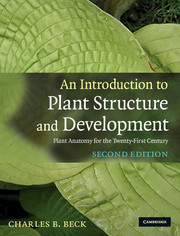Book contents
- Frontmatter
- Contents
- Preface to the second edition
- Preface
- Acknowledgements
- General references
- Chapter 1 Problems of adaptation to a terrestrial environment
- Chapter 2 An overview of plant structure and development
- Chapter 3 The protoplast of the eukaryotic cell
- Chapter 4 Structure and development of the cell wall
- Chapter 5 Meristems of the shoot and their role in plant growth and development
- Chapter 6 Morphology and development of the primary vascular system of the stem
- Chapter 7 Sympodial systems and patterns of nodal anatomy
- Chapter 8 The epidermis
- Chapter 9 The origin of secondary tissue systems and the effect of their formation on the primary body in seed plants
- Chapter 10 The vascular cambium: structure and function
- Chapter 11 Secondary xylem
- Chapter 12 The phloem
- Chapter 13 Periderm, rhytidome, and the nature of bark
- Chapter 14 Unusual features of structure and development in stems and roots
- Chapter 15 Secretion in plants
- Chapter 16 The root
- Chapter 17 The leaf
- Chapter 18 Reproduction and the origin of the sporophyte
- Glossary
- Index
- References
Chapter 14 - Unusual features of structure and development in stems and roots
Published online by Cambridge University Press: 05 June 2012
- Frontmatter
- Contents
- Preface to the second edition
- Preface
- Acknowledgements
- General references
- Chapter 1 Problems of adaptation to a terrestrial environment
- Chapter 2 An overview of plant structure and development
- Chapter 3 The protoplast of the eukaryotic cell
- Chapter 4 Structure and development of the cell wall
- Chapter 5 Meristems of the shoot and their role in plant growth and development
- Chapter 6 Morphology and development of the primary vascular system of the stem
- Chapter 7 Sympodial systems and patterns of nodal anatomy
- Chapter 8 The epidermis
- Chapter 9 The origin of secondary tissue systems and the effect of their formation on the primary body in seed plants
- Chapter 10 The vascular cambium: structure and function
- Chapter 11 Secondary xylem
- Chapter 12 The phloem
- Chapter 13 Periderm, rhytidome, and the nature of bark
- Chapter 14 Unusual features of structure and development in stems and roots
- Chapter 15 Secretion in plants
- Chapter 16 The root
- Chapter 17 The leaf
- Chapter 18 Reproduction and the origin of the sporophyte
- Glossary
- Index
- References
Summary
Perspective
A large part of this book, thus far, has dealt with the typical condition in stems of gymnosperms and dicotyledons. This chapter will present interesting and important information about stem growth in monocotyledons as well as development and patterns of organization in lianas (vines) and other plants usually characterized as having “anomalous” structure. Unlike gymnosperms and dicotyledons, monocotyledons, even the largest taxa among the palms, do not produce a typical vascular cambium. Although most are characterized solely by primary growth, some palms, some members of the Liliaceae and Agavaceae, and a few other monocotyledons increase in size by secondary growth. The tissues derived from the secondary meristem are strikingly different from the secondary xylem and phloem of the gymnosperms and other angiosperms.
Primary peripheral thickening meristem
As in other plants, the activity of apical meristems of monocotyledons results primarily in an increase in length of the stems. The diameter of a palm stem does not vary greatly from the base to the most distal leaf-bearing region; thus considerable diametric growth must occur in the internodes just beneath the apical meristem, and this is accomplished by activity of the primary peripheral thickening meristem. This meristem is a rather diffuse region located in the periphery of the broad region of the stem immediately below the apical meristem. Its longitudinal extent varies in different species.
- Type
- Chapter
- Information
- An Introduction to Plant Structure and DevelopmentPlant Anatomy for the Twenty-First Century, pp. 255 - 263Publisher: Cambridge University PressPrint publication year: 2010

